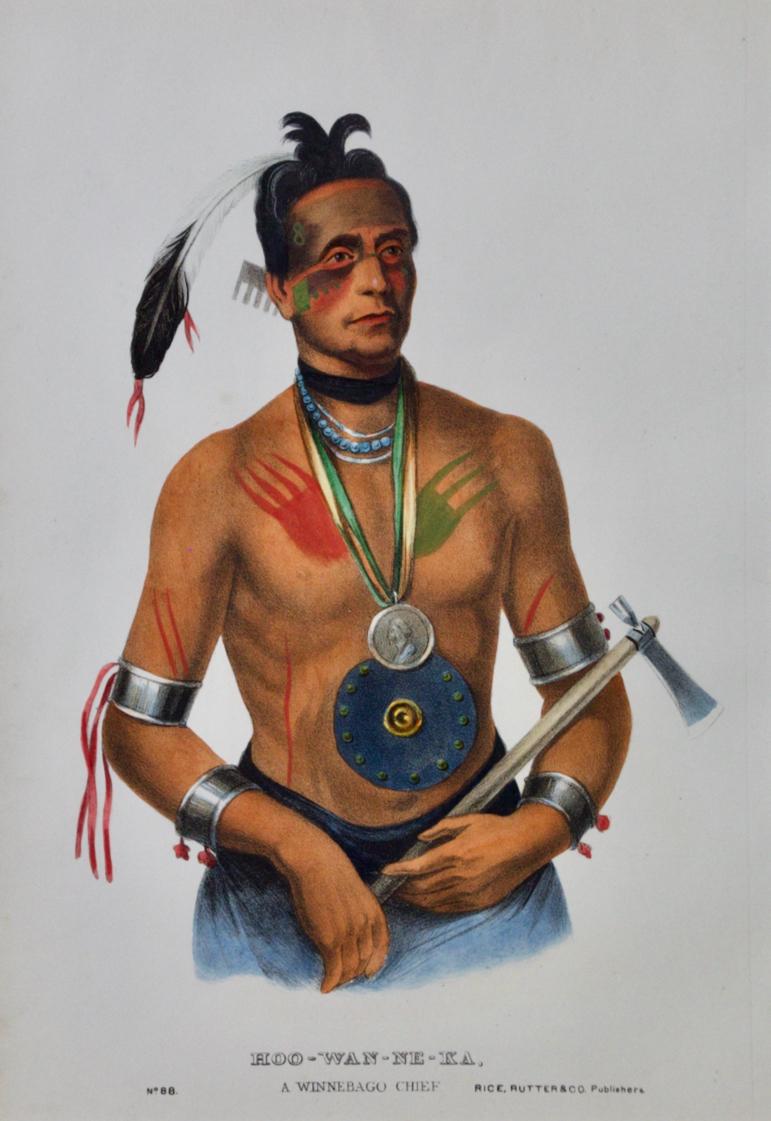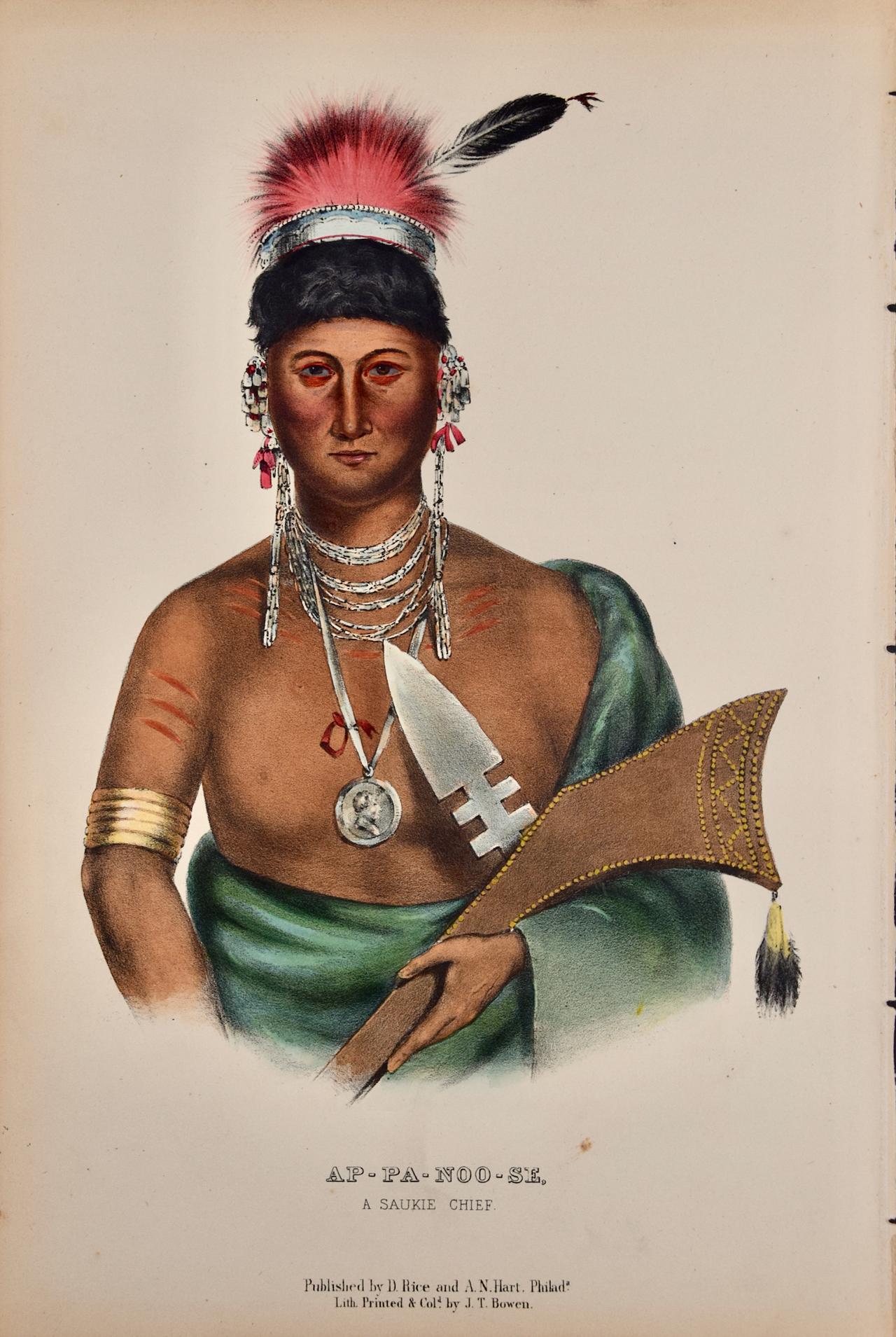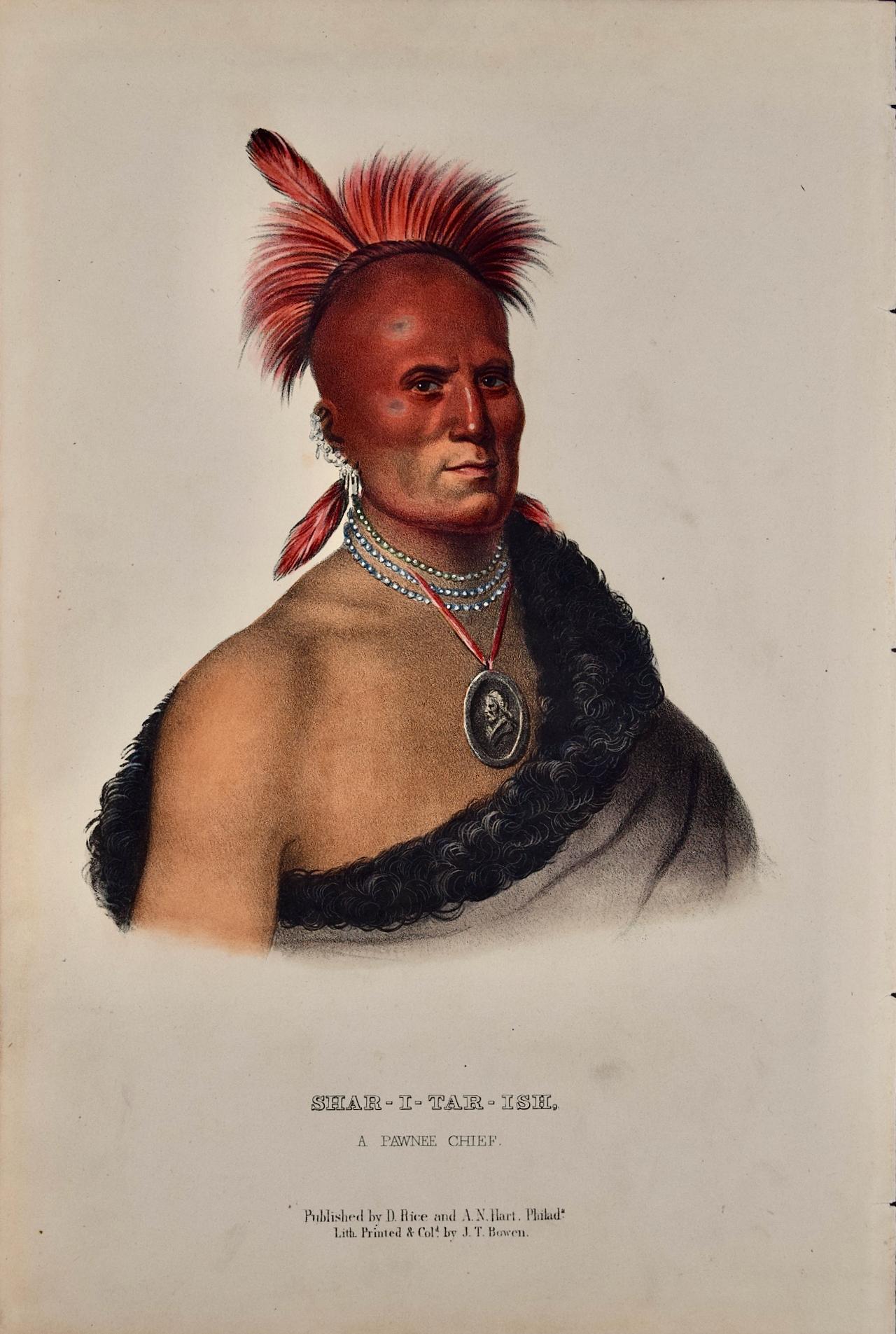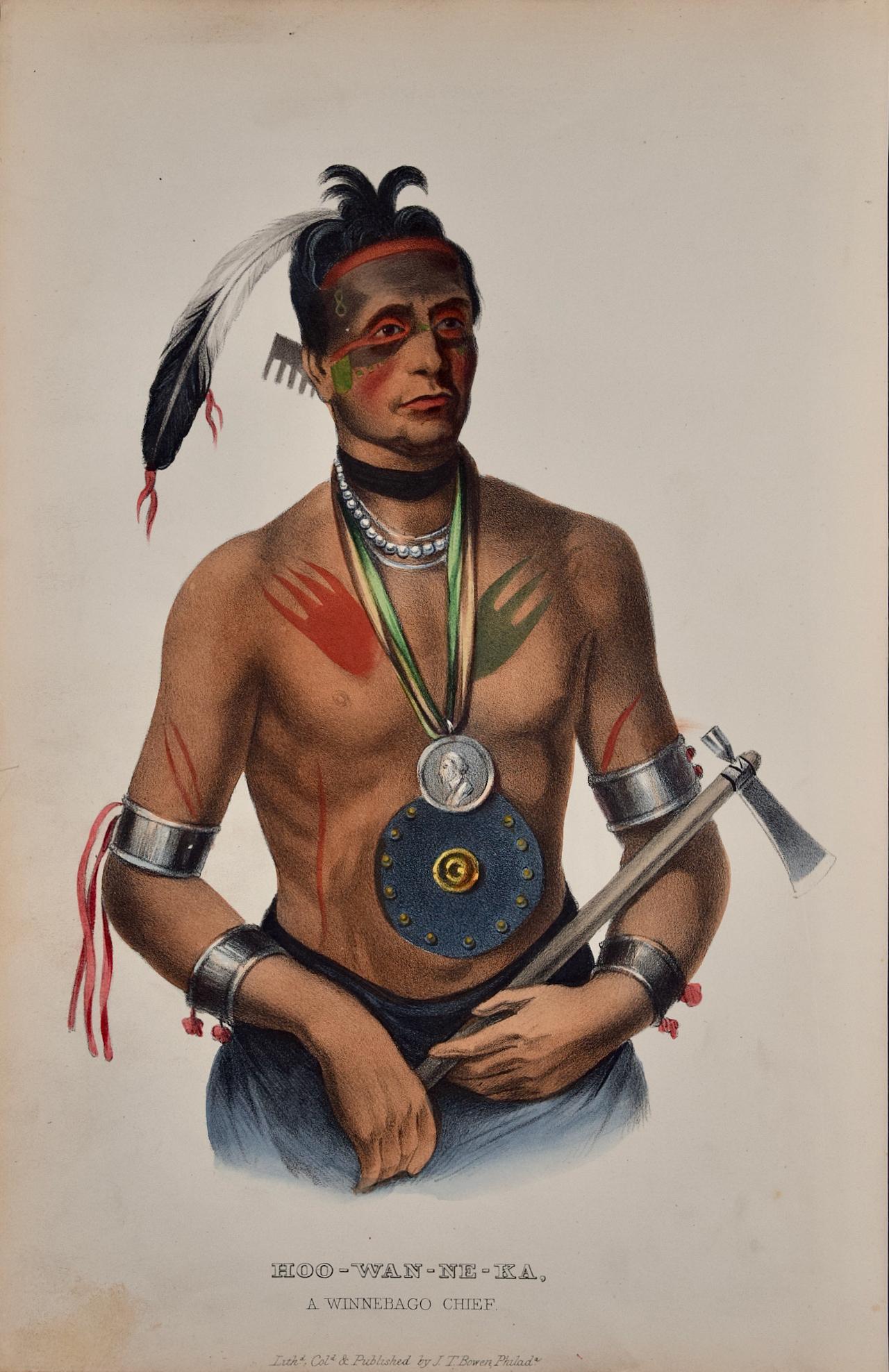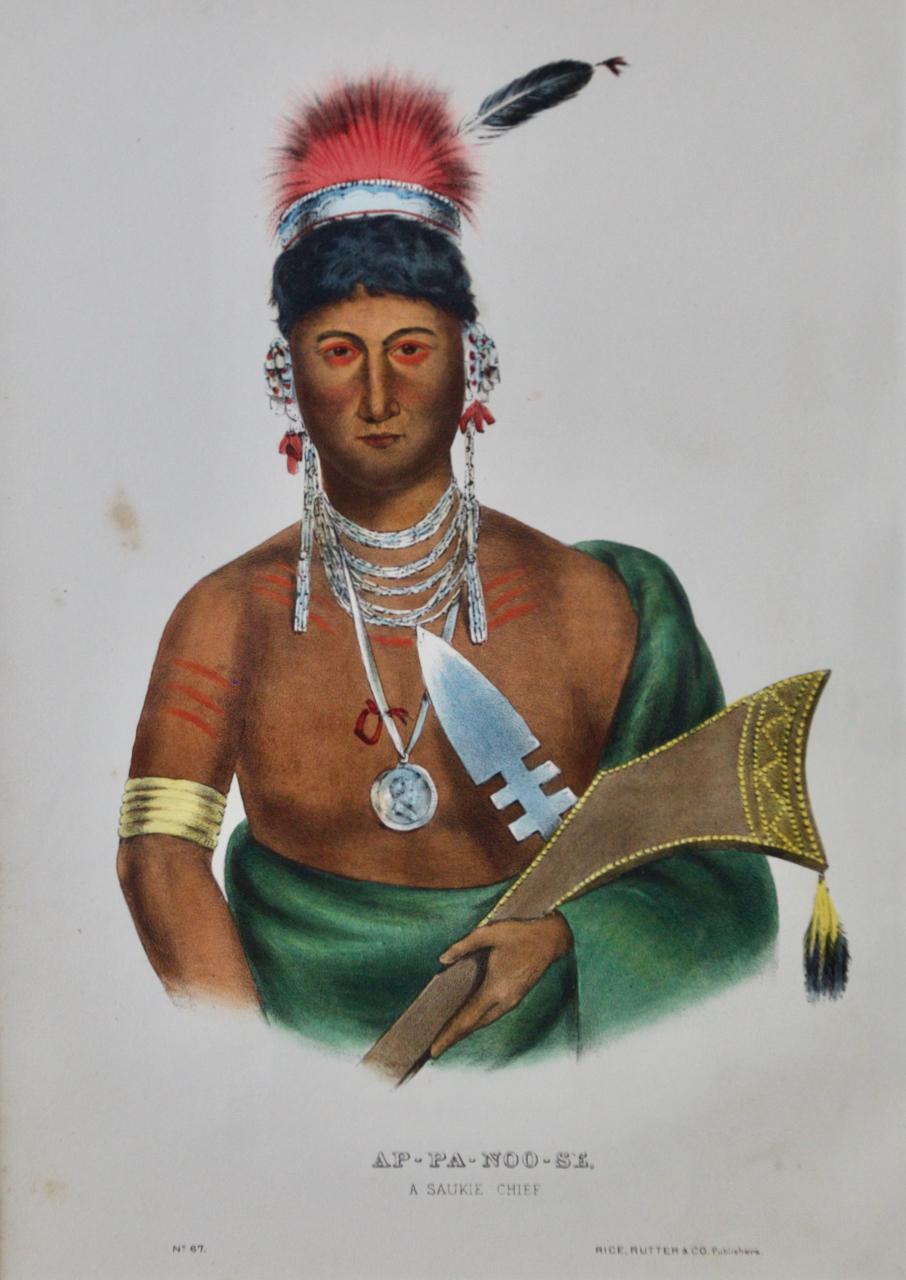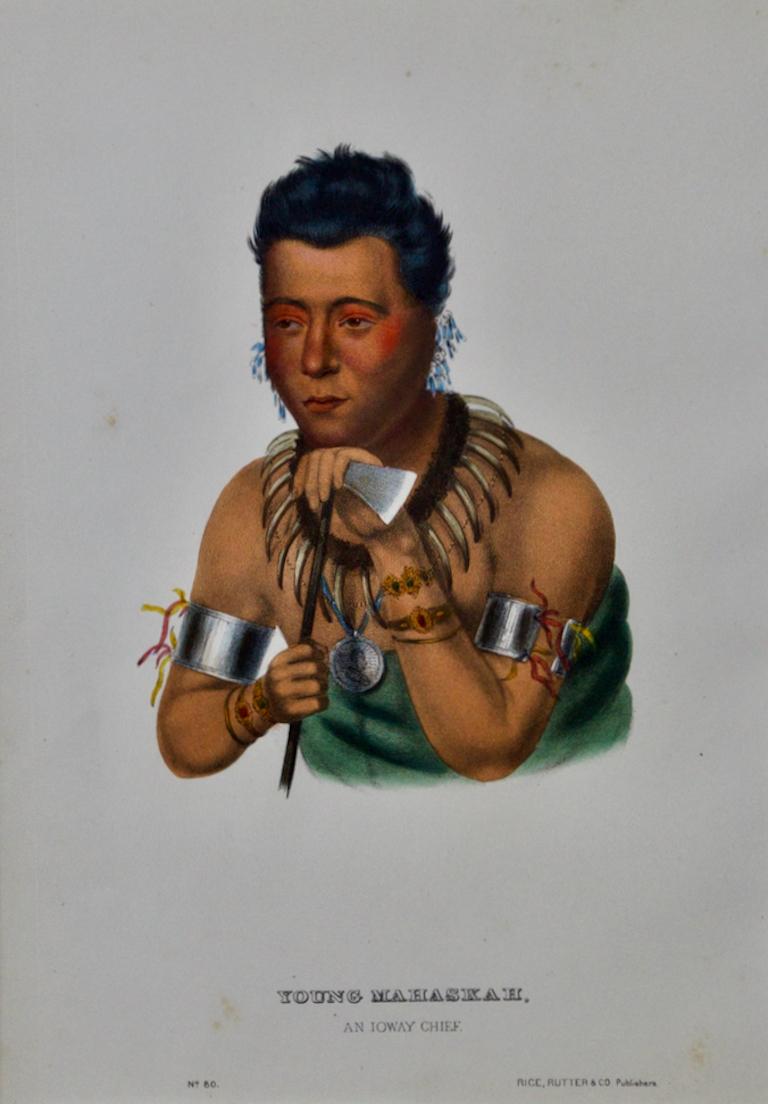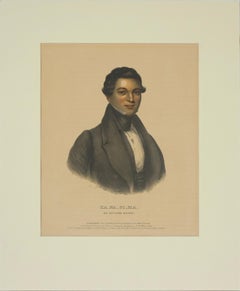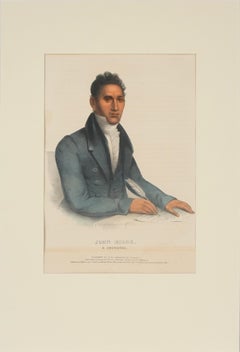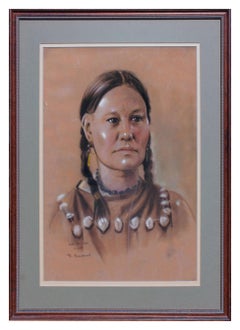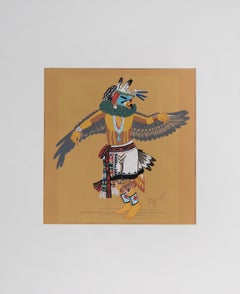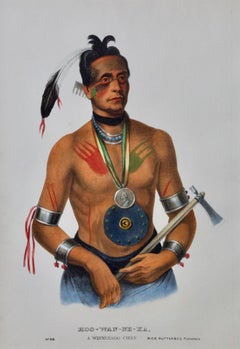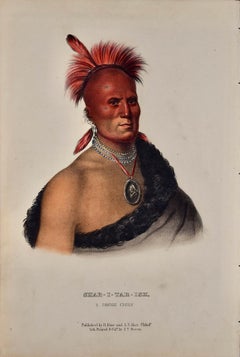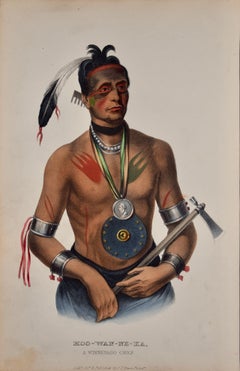Items Similar to Wakechai (Crouching Eagle) A Saukie Chief Lithograph with Applied Watercolor
Want more images or videos?
Request additional images or videos from the seller
1 of 9
Charles Bird KingWakechai (Crouching Eagle) A Saukie Chief Lithograph with Applied Watercolor1842
1842
$1,480
$1,85020% Off
£1,121.76
£1,402.1920% Off
€1,298.54
€1,623.1820% Off
CA$2,089.38
CA$2,611.7220% Off
A$2,326.69
A$2,908.3620% Off
CHF 1,214.82
CHF 1,518.5220% Off
MX$28,192.11
MX$35,240.1420% Off
NOK 15,320.11
NOK 19,150.1420% Off
SEK 14,455.73
SEK 18,069.6720% Off
DKK 9,693.46
DKK 12,116.8220% Off
About the Item
1842 Wakechai (Crouching Eagle) A Saukie Indian Chief Lithograph with Applied Watercolor
The lithograph depicts Wakechai, also known as Crouching Eagle, who was a member of the Sauk and Fox delegation. King renders Wakechai with exceptional detail. The Saukie Chief is adorned with fine accoutrements such as a white fur robe, silver arm band, glass bead pendant and black headpiece with ostrich feathers. Thomas McKenney, United States Superintendent of Indian Trade, conceived the idea for a series of portraits of prominent Native Americans who visited Washington D.C. in the early 19th century. An established portraitist by the early 1820s, King was commissioned by McKenney to execute the series, resulting in rich character studies of his sitters. Members of the Indian delegation of 1825, such as this sitter, often received copies of their portraits.
The Sauk, also known as the Sac, are a Native American tribe that lived in the Great Lakes region of the United States. They were part of the Algonquian language family and were closely related to the Fox and Kickapoo tribes.
Published by Daniel Rice & James G Clark. Philad.a
"Drawn, Printed and Colored at the Lithographic & Print Colouring Establish. 94 Walnut St. Phil"
"Entered according to act of Congress in the Year 1842 by James G. Clark, in the Cl.s Off.c of the Dis.t Ct of the Eastern Dist of Penn.a"
Condition: Very good; tonal aging due to age.
Presented in new conservation mat
Paper size: 19.75"H X 14"W
Image size: 16"H x 12"W
Mat size:24.3/8"H x 19.7/8"W
Born in Newport, Rhode Island, Charles Bird King became famous for his portraits of distinguished Native Americans. He studied with Samuel King, colonial painter, and then at age 15, ran away to New York City where he worked in the studio of Edward Savage. From 1805 to 1812, he lived in London, studying with Benjamin West and sharing a studio with Thomas Sully.
In 1816, he settled in Washington D.C., becoming the city's first significant resident artist. He did portraits of politicians and then spent 16 years on a commission to paint members of a five-tribe Indian delegation, which came to the city in 1821. The results became the basis of the National Indian Portrait Gallery. The originals burned, but lithography copies remain.
Thomas McKenney was the Superintendent of Indian Affairs under three Presidents -- Madison, Monroe & Adams and was instrumental in having lithographs published of King's work. McKenney's persistence was a blessing to the following generations because it happened that most of the original Charles Bird King paintings were destroyed in a fire at the then new Smithsonian Institution in 1865. So the only record we have today of most of these early Indians are in fact the lithographs made by McKenney. They stand as some of the finest and most important prints ever made in America.
A visitor to his office in the War Department near the White House would have seen a carefully collected ‘museum’ of Indian artifacts. There were buffalo hides, ceremonial pipes, clothing and even a full size canoe over the doorway. Importantly, there were also portrait paintings of many of the tribal Chiefs and Sub-Chiefs that had come to Washington to meet the Great White Father, accept gifts and peace medals and sign peace treaties. Most of these portraits were done by the well known artist Charles Bird King.
The ritual of inviting the Indian Chiefs to Washington was one of the original stated missions of the Lewis & Clark Expedition brilliantly initiated by Thomas Jefferson. The underlying strategy presented to a hesitant Congress by Jefferson was to not only explore the vast continent West of the Mississippi for future settlement but more immediately to control the rivers and fur trade that had been previously dominated by French and English interests.
However, McKenney’s ideas of treating the Indians fairly and with respect were ideologically not in line with the policies of the Andrew Jackson administration and therefore he was forced to resign his post in 1830. By this time, however, he had already had the idea of making a series of lithographs after the collection of Indian portraits. It was a project that took him the next fourteen years to complete -- through years of near bankruptcy, numerous printers and emotional distress.
His persistence was a blessing to the following generations because it happened that most of the original Charles Bird King paintings were destroyed in a fire at the then new Smithsonian Institution in 1865. So the only record we have today of these early Indians are in fact the lithographs made by McKenney. They stand as some of the finest and most important prints ever made in America.
- Creator:Charles Bird King
- Creation Year:1842
- Dimensions:Height: 24.38 in (61.93 cm)Width: 19.82 in (50.35 cm)Depth: 0.2 in (5.08 mm)
- Medium:
- Movement & Style:
- Period:
- Condition:Very Good; tonal aging to paper.
- Gallery Location:Soquel, CA
- Reference Number:Seller: D97071stDibs: LU54215699642
About the Seller
5.0
Platinum Seller
Premium sellers with a 4.7+ rating and 24-hour response times
Established in 1986
1stDibs seller since 2014
2,981 sales on 1stDibs
Typical response time: <1 hour
- ShippingRetrieving quote...Shipping from: Soquel, CA
- Return Policy
Authenticity Guarantee
In the unlikely event there’s an issue with an item’s authenticity, contact us within 1 year for a full refund. DetailsMoney-Back Guarantee
If your item is not as described, is damaged in transit, or does not arrive, contact us within 7 days for a full refund. Details24-Hour Cancellation
You have a 24-hour grace period in which to reconsider your purchase, with no questions asked.Vetted Professional Sellers
Our world-class sellers must adhere to strict standards for service and quality, maintaining the integrity of our listings.Price-Match Guarantee
If you find that a seller listed the same item for a lower price elsewhere, we’ll match it.Trusted Global Delivery
Our best-in-class carrier network provides specialized shipping options worldwide, including custom delivery.More From This Seller
View AllKa-Na-Pi-Ma, An Ottowa Chief Hand-Colored Lithograph
Located in Soquel, CA
KA-NA-PI-MA, AN OTTAWA CHIEF., from History of the Indian the Indian Tribes of North America, ca. 1842, hand-colored lithograph
The lithograph by Charles Bird King depicts Ka-na-pi...
Category
1840s Hudson River School Figurative Drawings and Watercolors
Materials
Watercolor, Laid Paper, Lithograph
$960 Sale Price
20% Off
John Ridge, A Cherokee Indian & Interpreter Lithograph with Applied Watercolor
Located in Soquel, CA
1838 John Ridge A Cherokee Indian and Interpreter Lithograph with Applied Watercolor
The lithograph depicts John Ridge, a Cherokee interpreter, by Charles Bird King (American, 1785 - 1862), published 1838. Compared to other indian portraits in tribal regalia, King's rendering of John Ridge appears to be different. King portrayed John Ridge in Anglo-American clothing, sitting at a desk with a document and pen in hand—hinting at Ridge’s education and career as tribal leader and politician. King was known for his realistic and sensitive renderings of his sitters, and his ability to capture their physical features and attire with dignity and attention to detail.
Condition: Good; tonal aging due to age; previous mat tonal aging marks
Presented in new conservation mat
Paper size: 19.75"H X 14"W
Image size: 15"H x 10"W
Mat size:24"H x 16"W
John Ridge received his education at Foreign Mission School in Cornwall, Connecticut and served as clerk of the Cherokee National Council. When King painted...
Category
1840s Hudson River School Figurative Drawings and Watercolors
Materials
Watercolor, Laid Paper, Lithograph
"Ear of Corn, Sioux", Mid Century Native American Portrait
By Robert Floodstrand
Located in Soquel, CA
"Ear of Corn, Sioux", Mid Century Native American Portrait
Beautiful mid century portrait titled "Ear of Corn, Sioux" by Robert Floodstrand (American, 19...
Category
Mid-20th Century Realist Portrait Drawings and Watercolors
Materials
Felt, Paper, Pastel
$475 Sale Price
32% Off
"Kachina Eagle Dancer" - 1939 Hopi Serigraph
Located in Soquel, CA
"Kachina Eagle Dancer" - 1939 Serigraph
Serigraph of a Kachina Eagle Dancer by Hopi Pueblo artist Kyrate Tuvahoema (Native American, 1914-1942). The Kachina Eagle Dancer wears a vib...
Category
1930s Impressionist Figurative Paintings
Materials
Paper, Ink
$1,200 Sale Price
20% Off
1830's Hand-colored Lithograph of a Ground Squirrel
By Thomas Doughty
Located in Soquel, CA
Wonderfully preserved hand-colored 1830's lithograph "Ground Squirrel" by Thomas Doughty (American, 1793 - 1856), circa 1830. From "The Cabinet of Natural History and American Rural Sports." Phila: J.&T. Doughty, 1830-32. Sold previously by Bland Gallery, Early 20th century East Side gallery specializing in miniatures. Presented in frame with new acid-free mat under plexiglass. Image size: 7.25"H x 8.75"W.
Doughty’s short-lived magazine “The Cabinet of Natural History and American Rural Sports” is an important imprint in the history of American printing. It contained the first colored sporting prints made in America. Issued in monthly parts and published from the end of 1830 until the spring of 1834, “The Cabinet” featured articles on hunting, detailed descriptions of newly discovered flora and fauna, and some of the finest examples of early American hand-colored lithography. It was originally the work of the Doughty brothers, Thomas and John, with virtually all of the plates being the work of Thomas, who also founded the Hudson River School. But, by the spring of 1832, the partnership had broken up and Thomas had moved to Boston. An abbreviated third volume lacked Thomas’ touch.
Printed by Childs & Inman, the partnership between Philadelphia engraver and lithographer Cephas G. Childs and New York portrait...
Category
1830s Realist Animal Prints
Materials
Paper, Ink
Hopi Kachina Dancer by Cliff Bahnimptewa
By Cliff Bahnimptewa
Located in Soquel, CA
Detailed and vibrant depiction of a kachina dancer by Cliff Bahnimptewa (Native American, 1937-1984). Signed and dated in the lower right corner. Pres...
Category
1970s Folk Art Figurative Paintings
Materials
Tempera, Postcard
You May Also Like
Hoo-Wan-Ne-Ka, Winnebago Chief: Original Hand-colored McKenney & Hall Lithograph
By McKenney & Hall
Located in Alamo, CA
This is an original 19th century hand-colored McKenney and Hall lithograph of a Native American entitled "Hoo-Wan-Ne-Ka, A Winnebago Chief", lithographed by J. T. Bowen after a paint...
Category
Mid-19th Century Naturalistic Portrait Prints
Materials
Lithograph
Ap-Pa-Noo-Se, A Saukie Chief: Original Hand-colored McKenney & Hall Lithograph
By McKenney & Hall
Located in Alamo, CA
This is an original 19th century hand-colored McKenney and Hall lithograph of a Native American entitled "Ap-Pa-Noo-Se, A Saukie Chief", lithographed by J. T. Bowen after a painting by Charles Bird King and published by Rice and Hart & Co. in Philadelphia in 1848. For his portrait Ap-Pa-Noo-Se (A Chief When a Child) is wearing a feathered headdress, long ornamental earrings, multiple chain necklaces...
Category
Mid-19th Century Naturalistic Portrait Prints
Materials
Lithograph
Shar-I-Tar-Ish, A Pawnee Chief: Original Hand-colored McKenney & Hall Lithograph
By McKenney & Hall
Located in Alamo, CA
This is an original 19th century 1st edition octavo hand-colored McKenney and Hall lithograph of a Native American entitled " Shar-I-Tar-Ish, A Pawnee Chief", lithographed by J. T. Bowen after a painting by Charles Bird King and published by Rice and Hart in Philadelphia in 1848. Shar-I-Tar-Ish's portrait has a reddish hue from the feathers in his headdress and amulet chain, with a brownish taupe color of the upper trim of his costume. He is wearing his presidential peace medal. He has a very serious and thoughtful expression.
This original McKenney and Hall hand-colored lithograph is printed on a sheet measuring 10.38" high and 7" wide. There are faint smudges in the margins. The print is otherwise in very good condition. The original descriptive text pages, 33-34, from McKenney and Hall's 19th century publication are included.
A famous Pawnee chief, Shar-I-Tar-Ish led his people during the early part of the 19th century. He was descended from a line of chiefs. Shar-i-tar-ish was a young man when he went to Washington in 1822 at the invitation of President James Monroe...
Category
Mid-19th Century Naturalistic Portrait Prints
Materials
Lithograph
Hoo-Wan-Ne-Ka, A Winnebago Chief: Original Hand-colored McKenney & Hall Litho
By McKenney & Hall
Located in Alamo, CA
This is an original 19th century 1st octavo edition hand-colored McKenney and Hall lithograph of a Native American entitled "Hoo-Wan-Ne-Ka, A Winnebago Chief", lithographed by J. T. Bowen after a painting by Charles Bird King and published by Rice and Hart in Philadelphia in 1848. For this portrait, Hoo-Wan-Ne-Ka appeared in the costume that he wore at the time of his address to Congress. McKenney described his costume as "...fantastic style, and clad in these wild and picturesque habiliments". This included a single feather and a comb in his hair, two metallic bands on each arm, a large medallion over his abdomen, a silver necklace and his presidential peace medal...
Category
Mid-19th Century Naturalistic Portrait Prints
Materials
Lithograph
Ap-Pa-Noo-Se, A Saukie Chief: Original Hand-colored McKenney & Hall Lithograph
By McKenney & Hall
Located in Alamo, CA
This is an original 19th century hand-colored McKenney and Hall lithograph of a Native American entitled "Ap-Pa-Noo-Se, A Saukie Chief", lithographed by J. T. Bowen after a painting ...
Category
Mid-19th Century Naturalistic Portrait Prints
Materials
Lithograph
Young Mahaskah, An Ioway Chief: Original Hand-colored McKenney & Hall Lithograph
By McKenney & Hall
Located in Alamo, CA
This an original 19th century hand colored McKenney and Hall engraving of a Native American entitled "Young Mahaskah, An Ioway Chief, No. 80", published by Rice, Rutter & Co. in 1865...
Category
Mid-19th Century Naturalistic Portrait Prints
Materials
Lithograph
More Ways To Browse
Antique Birds
Bird House
Chief Painting
Bird Lithograph
Three Bird Art
Antique Bird Painting
Birds Of A Feather
Antique Bird Stand
Antique Bird Lithographs
Antique Bird Houses
Feather Art Birds
King Lithograph
Antique Black And White Lithographs
H Hudson
Charles Bird
King Charles Painting
James King Artist
Charles White Lithograph
